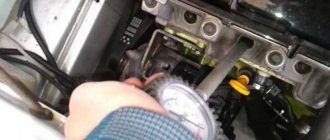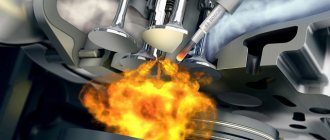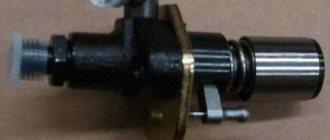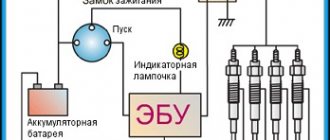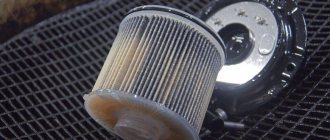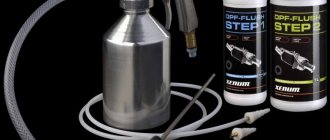Many car enthusiasts are interested in the question of how to check glow plugs in a diesel engine, since it is not always possible to start the car in cold weather. And there are some nuances here. The fact is that with several faulty spark plugs, a diesel engine can still be started, but only at an outside temperature of +5 °C. If this indicator is lower, then the car will not start even with one faulty spark plug.
Often, because the car is not started, many drivers postpone planned activities or switch to public transport. Only in reality it is possible to check the performance of the candles without resorting to the help of specialists. There are three methods that have already been time-tested and will provide answers to many questions. But first, a little theory regarding the operating principle of these elements will not hurt.
How do glow plugs work?
To find out how to check the glow plugs in a diesel engine without removing them, you need to familiarize yourself with the operating principle of these elements. And they, unlike their analogues for gasoline engines, function somewhat differently. The same can be said about their appearance - nothing in common. And if in units running on gasoline, a spark from a spark plug ignites the working mixture, then in diesel engines the fuel ignites due to pressure.
But there is also one nuance here: if it’s cold outside, the engine will not start, which is facilitated by cold air entering the working chamber. In this case, starting is difficult and the car needs to be warmed up. On older cars, the glow plugs come on every time the engine is started. In modern models they are not always activated, but only at negative temperatures.
The maximum temperature of the spark plug tip is 1350°C. There are two spirals inside it:
- heating;
- regulating.
With the first, everything is clear - it provides heating. The function of the latter is protective in nature, since it protects the spark plug from overheating as the temperature rises. This is done by increasing electrical resistance.
Signs of faulty glow plugs
Indirect signs of the presence of a malfunction:
- When starting, white-gray smoke comes . This indicates that fuel is flowing but is not igniting.
- Rough operation of a cold engine at idle . The noisy and harsh operation of the engine can be noticed by the shaking plastic parts of the interior due to the fact that the mixture in one cylinder ignites late due to the lack of heating.
- Difficulty starting a diesel engine when cold . You have to do several repetitions of spinning the engine with the starter.
Clear signs of a bad glow plug will be:
- Partial destruction of the tip .
- A thick layer of carbon deposits on the tip near the body.
- Swelling of the glow tube (occurs due to excess voltage).
How can you check the glow plugs of a diesel engine?
How to check?
Depending on the model and age of the car, there are different principles of operation of the diesel engine heating system:
- In older cars, glow plugs usually turn on almost every time the engine is started.
- Modern cars can start successfully even without glow plugs at above-zero temperatures.
Therefore, before starting to diagnose the diesel preheating system, you need to find out at what temperature conditions the combustion chamber is heated. And also, what type of candle, since they are divided into two groups: rod (the heating element is made of a refractory metal spiral) and ceramic (the heater is ceramic powder).
Environmental standards Euro 5 and Euro 6 provide for the operation of diesel engines with ceramic spark plugs, since they have a pre- and post-start heating function that allows the fuel to be burned in a cold engine, as well as an intermediate glow mode necessary to ensure regeneration of the particulate filter.
To check the spark plugs of a Ford, Volkswagen, Mercedes or other car diesel engine, you can use several methods , and depending on whether they are unscrewed or on the engine, the principle will be the same. Functionality testing can be done using:
3 ways to check glow plugs - video
- Battery _ On the speed and quality of incandescence;
- Tester . By checking the break of the heating winding or its resistance;
- Light bulbs (12V). The simplest test for breakage of the heating element;
- Sparking (can only be used in old diesel engines, since new ones are dangerous due to ECU failure);
- Visual inspection.
The simplest diagnosis of glow plugs is to check their electrical conductivity. The spiral must conduct current, its resistance in a cold state is in the range of 0.6–4.0 Ohm . If you have access to the candles, you can “ring” them yourself: not every household tester is able to measure such a low resistance, but any device will show the presence of a heater break (the resistance is infinity).
If you have a non-contact (induction) ammeter, you can do without removing the spark plug from the engine. But it is often necessary to inspect the working part, on which signs of overheating may be noticeable - melting, deformation of the tip, up to its destruction.
In some cases, in particular if all spark plugs fail at once, it may be necessary to check the vehicle's electrical equipment. Namely, the spark plug control relay and its circuits.
We will describe all the ways to check diesel glow plugs. The choice of each of them depends on skills, availability of equipment, tools and free time. But ideally, you need to apply everything together, plus a visual inspection.
Varieties of candles
When deciding how to check the performance of glow plugs on a diesel engine, you need to know what types of them exist. For diesel engines they are available in two types:
- ceramic;
- pin.
The former have a tip made of ceramic, which withstands temperature changes. The protective shell is made of silicone nitrite. The heating of such a spark plug reaches 1000°C, and the engine starts without problems. Such parts are highly efficient and have a long service life.
For pin candles, the heating element is made of an alloy of iron, chromium and nickel, and the internal cavity is filled with magnesium oxide. This candle works at intervals from 4 seconds to 2 minutes.
Useful tips
- Before the onset of the cold season, the glow elements should be checked regardless of whether the diesel engine starts well or poorly.
- Checking on a diesel engine by assessing the spark is recommended only for older cars. You should not test heating solutions in this way on a “fresh” model, which is equipped with a complex electronic engine control system.
- If a malfunction is detected, it is optimal to replace the entire set, rather than one or two failed elements.
- Try to purchase products from well-known manufacturers, since cheap solutions have a noticeably shorter service life and often demonstrate low efficiency of the heating element.
Finally, we would like to add that in order to reliably start a diesel engine in winter, it is necessary to correctly select, charge and maintain a diesel battery, refill high-quality diesel fuel according to the season, and use anti-gels if necessary. Also, in the case of diesel engines, it is advisable to install a diesel fuel pre-heater or a Webasto-type engine pre-heating system.
Signs of a non-working cylinder (tribbing and vibration) of a diesel engine. Troubleshooting: compression, diesel injectors, glow plugs, injection pump and others.
How to replace glow plugs on a diesel engine yourself. Necessary tools, features of removing spark plugs, important tips and recommendations.
Independent implementation of diesel fuel heating: fuel intake, coarse and fine filters. Installation of heating elements. Flow heating.
Choice of spark plugs between NGK and Denso manufacturers. How to choose candles and which brand to choose. Features and nuances during selection.
What you need to know when selecting spark plugs according to your car model: size, heat rating, interchangeability. Choosing candles by design, useful tips.
Purpose and design of spark plugs for a gasoline engine. Design features, types of spark plugs. Heat number, spark gap.
Without a relay, nowhere
As you know, diesel fuel ignites under pressure as a result of strong compression in the combustion chamber. The relay supplies the required current, which heats the tip. The resulting heat heats the intake manifold, engine cylinders and working mixture to the desired temperature. Now it is easier for the fuel to ignite when under high pressure.
But before moving on to the question of how to check the glow plugs on a Nissan Pathfinder (diesel) or any other brand, it’s worth considering one more point. Often the mixture ignites before it even enters the cylinder. The result of this is that the efficiency of the engine decreases or it refuses to start at all. In order to ensure the required heating mode, a glow plug relay is used. Thanks to it, the electrical circuit closes and opens as needed. This ensures the optimal degree of heating of the working mixture.
The relay itself, of course, does not regulate the heating operation, since this is the prerogative of the ECU, which relies on the readings of the OX and crankshaft sensors. Thanks to commands from the block, the circuit is closed and opened.
Modern diesel engines have the option of additional heating when the engine is already running. This allows you to reduce the noise level during operation of the power unit, as well as minimize the amount of harmful emissions into the environment.
Normal operation
Air heating is one of the distinguishing features of a diesel engine. The vast majority of cars have single-pole ("ground" - body) male plugs for each cylinder. These models draw 5-18 amps, while 1.7V bipolar heaters can draw up to 50 amps. Only in some ICE models the air is heated by a single heater screwed into the intake manifold.
When checking glow plugs, you need to know their normal warm-up time.
- Regular glow plugs - take up to 60 seconds to reach operating temperature.
- Fast glow plugs - up to 10 seconds. The special design of the heating element ensures faster heating.
- Self-regulating glow plugs in 5 seconds. The design consists of two series-connected coils, one of which provides rapid heating, and the other regulates and maintains the temperature. Even after the main preheat phase is turned off, the heating element continues to operate for approximately 3 minutes at high temperature (reheat) to improve THA combustion.
When checking glow plugs, pay attention to their heating. A good element should glow evenly from the tip.
The combustion chamber only covers a small area near the end of the rod, so this is where the amount of heat is most important.
Characteristic symptoms
You should think about how to check glow plugs in a diesel engine if there are the following characteristic signs:
- The engine can be started with great difficulty.
- At idle speed, the power unit operates unevenly.
- There is a white tint in the exhaust.
If the spark plugs were changed not so long ago, this may indicate a defect on the part of the manufacturer. Otherwise, you can be sure that one of the elements is faulty. In any case, it is necessary to carry out diagnostics by visiting a service station or doing everything yourself.
It is worth considering that problems with spark plugs manifest themselves well in the cold season (autumn or winter), while in summer it is quite difficult to determine the malfunction.
Diagnostic methods
In diesel engines, the glow plug is the weak link. It is this part that most often fails, and this can happen at the most inopportune moment. The consequences of such a malfunction will not take long to appear, especially in winter. In this case, you will not be able to start the car.
How to properly check glow plugs on a diesel engine? There are several ways:
- Checking for spark.
- Diagnostics with a multimeter.
- A good method with a light bulb.
It is worth considering them in detail, which will allow you to determine what related tools may be needed.
We diagnose without removing the spark plugs from the car
Among all the methods for testing the spark plug, the method of removing the injector is the most optimal if you think that when unscrewing it there is a high risk of breaking the heating element. On many engines, the edge of the pin can be seen through the threaded holes in the nozzle. Thus, by turning on the ignition on a cold engine, you can check the serviceability of the glow plug.
The injectors also become clogged when the engine is running, but it is almost impossible to unscrew them. Stuck injectors are removed using a hydraulic puller. or an inertia cartridge, which can be made by hand if necessary.
Checking for spark
Diagnosing a glow plug using a battery will provide more accurate information regarding the performance of the element. Moreover, each detail is checked individually.
There is only one nuance here, which for some drivers may be a significant drawback. The point is that you need to unscrew all the spark plugs. This will take a lot of time, especially if you need to dismantle individual parts that block access to the spark plugs. Otherwise, there are no difficulties in solving the problem of how to check glow plugs in a diesel engine.
For diagnostics you will need an insulated wire 0.5-1.0 m long. The whole procedure is as follows:
- One end of the wire is wound to the electrode of the spark plug (you must first remove part of the insulation from it).
- The other end of the wire is applied to the negative terminal of the battery.
- The spark plug body is connected to the positive contact of the battery.
The whole picture will become clear here: if the tip turns red by more than half, then this indicates the serviceability of the glow plug. Otherwise, there will be no heating at all or only the tip will turn red. This already means that the part can only be replaced.
What is important to know
A car engine works in tandem with a large number of elements. Undoubtedly, one of the most important is the electronic control unit. It is he who calculates the time that the candles should work. The ECU is guided by readings from the temperature sensor. The relay, in fact, is located between the ECU and the glow plugs themselves, so as soon as one element malfunctions or fails altogether, the entire chain collapses. But here, too, not everything is so simple. Let's figure it out.
Modern diesel cars use what is called two-stage heating of the pre-chambers . Of course, it is gradually being replaced by a single-stage one, but since the system is still relevant, it would be useful to know why spark plugs may not work properly. Look here:
- At the 1st stage, the spark plugs receive power from a voltage source of about 11-12 Volts . When the spark plugs warm up, this voltage drops to 9 Volts. The first stage is before starting the engine. When the engine can be started, the warning light on the instrument panel goes out. You can move to the second stage;
- Already at the 2nd stage, the voltage decreases noticeably: 5-7 Volts . The temperature of the spark plugs, of course, is lower - now they only maintain the stability of the engine before it reaches the optimal temperature.
Spare parts for Volkswagen golf
Glow plug relay
GOLF III hatchback (1H1) (08.91 - 07.98)
Spare parts for Audi 80
Glow plug relay
80 sedan (89, 89Q, 8A, B3) (06.86 - 10.91)
We considered it necessary to note all this for one simple reason: if the ECU malfunctions or if the standard relay has been replaced with an unsuitable one, normal operation of the spark plugs is simply impossible. If the relay does not work, then the spark plug does not work either - during periods of severe cold, this puts an end to any attempt to start the engine.
We will continue to study the system so that the car enthusiast in the future will clearly know what the problems in the fuel heating system are associated with. Between the relay and the glow plug there is a current-limiting resistor - the most common resistor that prevents the plug from failing under the influence of overcurrents. The resistor is also connected to the motor control unit (it would be more correct to say that with a separate current sensor on this unit), and based on its serviceability, the unit judges whether the glow plugs are still working. When replacing glow plugs, inexperienced or inattentive repairmen forget to connect the wire from the current-limiting resistor to the ECU. For this reason, the entire glow plug system fails.
Diagnostics with a multimeter
This method is good because there is no need to remove candles and other parts, since the necessary manipulations can be easily done on the spot. All you need is the testing device itself. In this case, you can check each spark plug separately or all at the same time, having previously connected them via a common bus.
How to check glow plugs on a diesel engine with a multimeter? The entire procedure can be carried out in one of three modes:
- dialing;
- resistance measurement;
- current measurement.
To make a call you need:
- Move the device regulator to the appropriate position, and place the device itself in a convenient place.
- Disconnect the wire from the spark plug.
- One probe of the device is applied to the spark plug body, and the other to its electrode.
The presence or absence of a break can be determined by the sound signal. If it is there, then everything is in order (there is no break). If there is no sound signal, then this indicates the presence of a break.
How to unscrew and replace
- Remove glow plugs only when the engine is warm.
- Fill the hole with kerosene, brake fluid or penetrating lubricant several hours before the inspection.
- Immediately before disassembly, blow out the spark plug holes with compressed air to prevent dirt from getting into the cylinders.
- Do not try to unscrew the part in one go if you feel that the base is starting to deform, but the spark plug is not giving up. After turning or half a turn in one direction, tighten it the same amount in the opposite direction before trying to unscrew it again.
- Before screwing in a new element, clean the threads with a trowel to remove soot and deposits.
- Apply sealing anti-seismic lubricant. Some designs may use a sealant to prevent moisture from entering the spark plug socket.
- Do not over-tighten the feed clamp mounting nut.
- Be sure to use a torque wrench when tightening.
Resistance measurement
With this method, you can only identify a completely non-functioning spark plug. However, it is impossible to determine how well the heating element itself works. In this case, you can measure the resistance value with the same multimeter, you just need to know the rating of a specific spark plug. As a rule, if the part is intact, then the resistance should be 0.7-1.8 ohms. This is also an effective method of checking the glow plug in a diesel engine with a tester.
Often spark plugs fire with a high resistance value, which leads to a decrease in current consumption. In this case, the computer “thinks” that these elements have warmed up and turns them off.
Current measurement
A more reliable result can be obtained by measuring the current, and it is also not necessary to unscrew the spark plug. First you need to unfasten the power wire and connect the probe of the device. Fix the second probe with the spark plug electrode. Now all that remains is to turn on the ignition and observe the readings. If the part is working properly, then the display should show numbers in the range of 5-18 A.
It is worth noting that in the first second the values will jump to the limit, and after 3-4 seconds the current will stabilize. In this case, the reduction in data should be gradual, without sudden jerks.
All spark plugs are checked in this way; their readings should be identical. Otherwise, if the readings of one of the spark plugs are excellent, it is worth unscrewing it and assessing its condition visually.
Good method with a light bulb
How to check the glow plug in a diesel engine with a light bulb? Yes, and with its help you can also detect a malfunction. Any 21 W light source (side lights or brake lights) is suitable for this. Two pieces of wire are soldered to it (the length is chosen arbitrarily). After this, you can proceed directly to the diagnostic procedure.
First disconnect the power wire from the spark plug. Then touch one end of the lamp wire to the spark plug electrode, and connect the other end to the positive contact of the battery. The glow of the light bulb will indicate that there is no break. Thus, you need to check all the candles one by one.
If the light bulb lights up dimly or there is no light at all, then it is better to replace such a candle. This method also does not provide reliable diagnostics, since it is impossible to determine the degree of heating of the working rod.
Replacing an element
When the test shows that the device is not functioning, it needs to be replaced. Even a less experienced car enthusiast can do this. To do this, you will have to disconnect all the terminals from the part and take it out. Then it is important to clean the place where the device was removed. Then you need to carefully unscrew all the spark plugs. Next, carry out the entire process in reverse order, only with a new block: screw the glow parts into the new block, install it in a previously cleaned place.
The location of the candles is shown by red arrows
After this, you should try to start the engine. If this does not work, then you need to check whether all terminals are connected. If everything is installed correctly, but the engine still does not start, then the problem was probably not in the glow elements.
It is important to note that different vehicles may require different types and models of glow elements.
Owners of cars running on diesel fuel should prepare in advance for the cold season and check the functionality of the relay. It is also worth keeping control over the candles themselves. It is especially important to check the performance before a long journey. Otherwise, the trip may be disrupted and postponed until the problem is resolved.
Features of checking the spark plug relay
Many car enthusiasts are interested in one important point: how to check the glow plug relay on a diesel engine? The question is interesting and requires deserved attention.
Typically, such a device is triggered after each engine start. At the same time, you can hear a clearly audible click - this is how it turns on. If there are no sounds, you should think about diagnosing this element. However, it is worth finding it first.
This device looks like a box that is attached to the body of a car. The area of its fixation is usually called mass. To find the relay, just follow the wires coming from the glow plugs.
Each such device has several pairs of contacts. Single-component relays have 4 of them, and two-component relays have 8. Two of them are removed from the coil winding, and the rest are control ones, which close when they receive a signal.
So how to check the glow plug relay on a diesel engine? In each car, the contacts are designated differently, but in most cases they are numbered as 85 and 86, and the control ones - 87, 30. To check, you can use a light bulb, which is connected to the winding contacts, after which voltage is applied to the relay. The serviceability of the device will be confirmed by the glow of the lamp.



